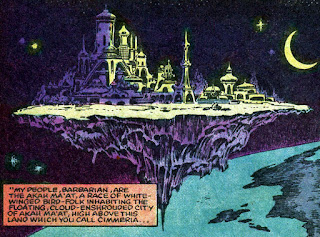My recent post on "vanilla" fantasy made me think of Weirdworld and this post from 2010...
"For those who thrilled to J.R.R. Tolkien's "Lord of the Rings"--An All New Adventure into Epic Fantasy!"
So cried the cover blurb on
Marvel Premiere #38, the second appearance--first in color--of Marvel's decidedly
un-Sword & Sorcery fantasy series. As such, it stands as an interesting artifact in comics history, fitting neither with the pulp inspired fantasies of earlier comics, or the D&D-influenced ones that were to follow.
The titular "Weirdworld" is a fantasy land inhabited by dwarves, elves, and goblins, and perpetually under threat from wicked sorcerers and other magical menaces. Its protagonists are two elves--Tyndall and Velanna--who are outcasts with mysterious (even to themselves) pasts. Their obligatory companion and comedy relief is Mud-Butt, an irascible dwarf.
Tyndall starts out solo and in black and white in
Marvel Super Action #1, where he good-naturedly undertakes a quest on behalf of bigoted dwarvish villagers in "An Ugly Mirror on Weirdworld" (1976). Velanna joins him by that story's end, and they run afoul of a rejuvenation-seeking sorcerer in
Marvel Premiere #38 (1977). Their next appearance, publication wise, would see them travelling with Mud-Butt to the City of Seven Dark Delights and crossing paths with the sorcerous Dark Riders, who were seeking to resurrect their fallen god, Darklens. The defeat of Darklens and the discovery of other elves, were related in the three part epic, "Warriors of the Shadow Realm" in
Marvel Super Special #11-13 (1979).
Epic Illustrated #9, and #11-13, in 1981 and '82, featured the "Dragonmaster of Klarn" storyline, that revealed more about the mysterious elves and their relationship with dragons. Finally, in 1986,
Marvel Fanfare vol. 1 #24-26 saw a lost tale of Weirdworld--the first meeting of Mudd-Butt and the two elves, and vanquishing of yet another evil sorcerer. Work on this story had actually began back in the seventies, but it had been left unfinished.
Weirdworld was the creation of Doug Moench, and artistically designed, at least initially, by Mike Ploog. "Warriors of the Shadow Realm" had art by John Buscema, and featured a redesigned Mud-Butt--though no one knew it, since Ploog's original design didn't see print until nearly a decade later. Pat Roderick provided the pencils for the last two
Marvel Fanfare issues.
I would have thought Weirdworld bore the influences of Bakshi's animated fantasy features
Wizards and
The Lord of the Rings--but it actually predates both of them. Any artistic resemblance may be due to Ploog's reported involvement in those two projects, or it may be coincidental. Tolkien would seem to be a likely source, but Moench maintained in that he had never read
The Lord of the Rings in his essay on Weirdworld's origins in
Marvel Super Special #11. He
did admit to having read
The Hobbit in high school, but denied remembering much about it.
Despite the superficial "Tolkienian" elements, I think we see in Weirdworld an artifact of a time when
The Lord of the Rings-style portrayals of elves and dwarves (by way of D&D) were not taken as standard. The dwarves of Weirdworld bear more resemblance to the Munchikins of Oz than the ones from the Mines of Moria. Buscema's artwork in particular gives most of Weirdworld a kind of fairy-tale-ish look (inspired by
Arthur Rackham, among others) that reminds me a little of later works by
Brian Froud. The elves are likewise not wise and puissant beings superior to men in every way. Instead, their short and maybe more like non-Tolkien, pop-culture elves--like the sort that sell cookies or work for Santa. They're probably part of the pre-Tolkien lineage that influenced early D&D art (as James Maliszewski outlined
here) and certainly seem to be kin of hapless Indel in the 80s
D&D comic book ads.
Weirdworld offers a portrayal of stock rpg elements refreshingly free from the influence of the rising cultural familiarity with
The Lord of the Rings, and the ouroboros-like D&D-ization of fantasy. Nothing in it is new, but their might be something there worth revisiting.

























































